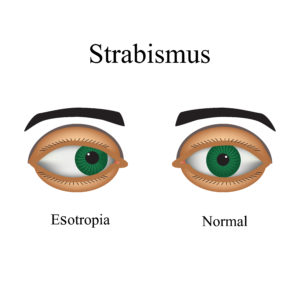
What is it?
Strabismus, recognized as crossed eyes, is an eye disorder that results in eye misalignment when focusing on an object. This condition can be present at birth or arise during child development. The cause of strabismus has not been explicitly identified, although the disorder has a higher occurrence within families. The condition may also emerge following brain trauma or a serious infection. Treatment for strabismus may involve surgery, eye patches or glasses. If it is not treated early in children, they can develop permanent vision loss in one eye in children and they can also develop amblyopia
How to Prepare
If a parent notices misalignment in the child’s eye, he or she should make an appointment to see a doctor. If the patient is an infant or young child, the patient’s parents should check the child’s eyes occasionally for strabismus or lazy eye. Parents should also be prepared to discuss recent infections, injuries, or other relevant records of medical history.
What happens during the procedure?
Treatment for strabismus begins with an eye exam. Patients receive a physical inspection of the eye from an ophthalmologist. Patients may be given reflex and visual acuity tests. After the doctor has determined the severity of the condition, an individualized treatment plan is devised. For milder cases of strabismus, patients may be advised to complete ocular exercises or wear glasses to alleviate symptoms and correct the ocular muscles. Surgery for strabismus involves multiple small incisions to access the muscles on the sides of the eye. Surgeons strengthen, weaken, or otherwise alter the muscles depending on the patient’s condition.
Risks and Complications
* Undercorrection
* Overcorrections
* Dry eyes
* Fibrosis (scarring)
* Vision loss
* Diplopia (double vision)
* Bleeding
* Eye infections
* Amblyopia
Disclaimer:
All GlobeHealer Site content, including graphics, images, logos, and text, among other materials on the site are for educational purposes only. This content is not intended to be a substitute for professional medical advice, and you should always contact your physician or qualified health provider for information regarding your health. Information on this site regarding the overview, diagnosis, and treatment of any kind should be looked at, in addition to the advice and information of your health care professional. Do not disregard medical advice or delay seeking treatment or medical advice due to information found on the GlobeHealer site.
If there is even the possibility that you may have a medical emergency, seek treatment, call your doctor, or call your local emergency telephone number immediately. GlobeHealer does not endorse being the first line of communication in case of emergency and does not endorse any specific test, physician, facility, product, procedure, opinion, or other information that is or may be mentioned on this site or affiliated entities. Reliance of any and all information provided by GlobeHealer, its employees, affiliations, others appearing on the Site under the invitation of GlobeHealer, or visitors of the site is solely at your own risk and is not the responsibility of GlobeHealer.
